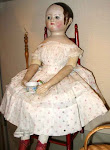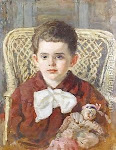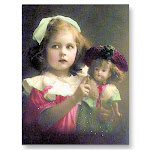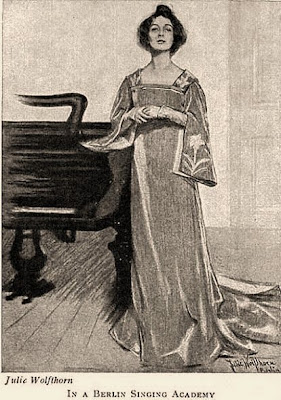 Pre Raphaelite Girl Light Blue dress red . Millais's art by the late eighties was influenced by Gainsborough's watercolour type technique in oil, with paint being thinly applied, a supreme example being the lovely "Little Speedwells Darling Blue" 1892 (Lady lever Art Gallery)
Pre Raphaelite Girl Light Blue dress red . Millais's art by the late eighties was influenced by Gainsborough's watercolour type technique in oil, with paint being thinly applied, a supreme example being the lovely "Little Speedwells Darling Blue" 1892 (Lady lever Art Gallery) Little Miss Muffett (Private Collection), photographed at the centenary exhibition in Southampton . It is thought that the girls in Spring (of 1859) were also eating "curds and whey" as the nursery rhyme would have it; although beyond that, there is no pictorial connection.
Little Miss Muffett (Private Collection), photographed at the centenary exhibition in Southampton . It is thought that the girls in Spring (of 1859) were also eating "curds and whey" as the nursery rhyme would have it; although beyond that, there is no pictorial connection. Dante Gabriel Rosetti ca. 1868
Dante Gabriel Rosetti ca. 1868 *************************************

In Europe towards the end of the nineteenth century interest in all things Japanese was growing, and strongly influenced the artists of the time. George Hendrik Breitner, who painted this scene, was also affected for a time by Japanism. In the years 1893-1894 he painted seven 'girls wearing a kimono' in various poses.
 Camille Monet in Japanese Costume, Monet
Camille Monet in Japanese Costume, Monet
 "The Japanese Doll" Eschwarzer
"The Japanese Doll" Eschwarzer

For Oscar Wilde the contemplation of beauty for beauty's sake was not only the foundation for much of his literary career but was quoted as saying "Aestheticism is a search after the signs of the beautiful. It is the science of the beautiful though which men seek the correlation of the arts. It is, to speak more exactly, the search after the secret of life."
 "Abelard and Heloise" Robert Bateman, Pre-Raphaelite painting.
"Abelard and Heloise" Robert Bateman, Pre-Raphaelite painting.
Aestheticism had its forerunners in John Keats and Percy Bysshe Shelley, and among the Pre-Raphaelites
The artists and writers of the Aesthetic movement tended to hold that the Arts should provide refined sensuous pleasure, rather than convey moral or sentimental messages. As a consequence, they did not accept the conception of art as something moral or useful. Instead, they believed that Art did not have any instructive purpose; it need only be beautiful. The Aesthetes developed the cult of beauty, which they considered the basic factor in art. Life should copy Art, they asserted.

Girl in White Kimono
*************************************
In Europe towards the end of the nineteenth century interest in all things Japanese was growing, and strongly influenced the artists of the time. George Hendrik Breitner, who painted this scene, was also affected for a time by Japanism. In the years 1893-1894 he painted seven 'girls wearing a kimono' in various poses.
 Camille Monet in Japanese Costume, Monet
Camille Monet in Japanese Costume, Monet "The Japanese Doll" Eschwarzer
"The Japanese Doll" Eschwarzer
For Oscar Wilde the contemplation of beauty for beauty's sake was not only the foundation for much of his literary career but was quoted as saying "Aestheticism is a search after the signs of the beautiful. It is the science of the beautiful though which men seek the correlation of the arts. It is, to speak more exactly, the search after the secret of life."
 "Abelard and Heloise" Robert Bateman, Pre-Raphaelite painting.
"Abelard and Heloise" Robert Bateman, Pre-Raphaelite painting.Aestheticism had its forerunners in John Keats and Percy Bysshe Shelley, and among the Pre-Raphaelites
*************************************



 Mr. and Mrs. Isaac Newton Phelps Stokes Oil on canvas 1897 by John Singer Sargent
Mr. and Mrs. Isaac Newton Phelps Stokes Oil on canvas 1897 by John Singer Sargent
 Catherine Vlasto by John Singer Sargent
Catherine Vlasto by John Singer Sargent
************************************

Ever the aesthete, Wilde himself was profoundly affected by beauty and lived and dressed flamboyantly compared to the typical Victorian styles and mores of the time. He was often publicly caricatured and the target of much moral outrage in Europe and America.

 A Private View at the Royal Academy, 1881 is a painting by the English artist William Powell Firth exhibited at the Royal Academy of Arts (London) in 1883.
A Private View at the Royal Academy, 1881 is a painting by the English artist William Powell Firth exhibited at the Royal Academy of Arts (London) in 1883.
Depicting the contrast between Aesthetes and Victorian fashions of the late 19th century.
 Edwardian Children in Costumes
Edwardian Children in Costumes
 Racinet, Regency Empire shawls ca. 1888
Racinet, Regency Empire shawls ca. 1888
%E2%80%99+by+Dante+Gabriel+Rossetti,+1868..jpg) Jane Morris "The Blue Silk Dress" Dante Gabriel Rosetti ca. 1868
Jane Morris "The Blue Silk Dress" Dante Gabriel Rosetti ca. 1868
 "Dress Reform"
"Dress Reform"
************************************
 "Gertie Millar" Australian Gibson Girl
"Gertie Millar" Australian Gibson Girl

 "Woman with Lily" courtesy of George Eastman House ca. 1905
"Woman with Lily" courtesy of George Eastman House ca. 1905



 Carnation Lily, Lily Rose...John Singer Sargent
Carnation Lily, Lily Rose...John Singer Sargent
*****************************************
Aesthetic dress worn for a recital "In a Berlin Singing Academy" in Max von Boehn's Modes and Manners of the 19th Century.



Wilde famously toured the United States in 1882. He travelled across the United States spreading the idea of Aesthetics in a speech called "The English Renaissance." In his speech he proposed that Beauty and Aesthetics was not "not languid but energetic. By beautifying the outward aspects of life, one would beautify the inner ones." The English Renaissance was, he said, "like the Italian Renaissance before it, a sort of rebirth of the spirit of man".

This view of aesthetics was entirely new to the United States and took root not only in the parlors of New York, but in the mining town of Leadville, Co.


In 'A Woman of No Importance' , Oscar Wilde wrote 'Moderation is a fatal thing, Lady Hunstanton. Nothing succeeds like excess.' This statement highlighted the conspicuous consumption of Edwardian society hostesses. These ladies were an almost different breed from ordinary women. Their like was never seen again after the First World War, not even in the ostentatious 1980s.
 Mr. and Mrs. Isaac Newton Phelps Stokes Oil on canvas 1897 by John Singer Sargent
Mr. and Mrs. Isaac Newton Phelps Stokes Oil on canvas 1897 by John Singer Sargent Catherine Vlasto by John Singer Sargent
Catherine Vlasto by John Singer Sargent************************************
"The studio was filled with the rich odour of roses, and when the light summer wind stirred amidst the trees of the garden, there came through the door the heavy scent of the lilac, or the more delicate perfume of the pink flowering thorn."
The opening line of "The Picture of Dorian Gray"

Ever the aesthete, Wilde himself was profoundly affected by beauty and lived and dressed flamboyantly compared to the typical Victorian styles and mores of the time. He was often publicly caricatured and the target of much moral outrage in Europe and America.
His writings, such as Dorian Gray, also brought much controversy for him but he was part of the ever-growing movement of 'decadents' who advocated pacifism, social reform, and libertarianism. While many vilified him, he was making his mark with style and wit and enjoyed much success with many of his plays. Wilde was lauded by and acquainted with many influential figures of the day including fellow playwright George Bernard Shaw, American poets Walt Whitman and
Henry Wadsworth Longfellow.
Henry Wadsworth Longfellow.

The Aesthetes' commitment to their theories and beliefs was so strong that eventually aestheticism transcended the boundaries of art and became a way of life. This meant that an aesthete was not only confirmed as such by his work, but also by his behavior. For example, one could typically pick out an aesthete simply by his word choice. They tended to use exaggerated metaphors and superlative adjectives, like "supreme, consummate, utter, and preciously sublime" (Damrosch 1939).
 A Private View at the Royal Academy, 1881 is a painting by the English artist William Powell Firth exhibited at the Royal Academy of Arts (London) in 1883.
A Private View at the Royal Academy, 1881 is a painting by the English artist William Powell Firth exhibited at the Royal Academy of Arts (London) in 1883.Depicting the contrast between Aesthetes and Victorian fashions of the late 19th century.
The Bromley Children ca. 1843 by Ford Maddox Brown
 Edwardian Children in Costumes
Edwardian Children in Costumes Racinet, Regency Empire shawls ca. 1888
Racinet, Regency Empire shawls ca. 1888%E2%80%99+by+Dante+Gabriel+Rossetti,+1868..jpg) Jane Morris "The Blue Silk Dress" Dante Gabriel Rosetti ca. 1868
Jane Morris "The Blue Silk Dress" Dante Gabriel Rosetti ca. 1868 "Dress Reform"
"Dress Reform"************************************
More comfortable attire was part of the aesthetic movement in an attempt to reform the artificial nature of the 1880s and '90s fashion with its call for stays, corsets, added bustle forms, ribbons and lace.
 "Gertie Millar" Australian Gibson Girl
"Gertie Millar" Australian Gibson Girl
 "Woman with Lily" courtesy of George Eastman House ca. 1905
"Woman with Lily" courtesy of George Eastman House ca. 1905
Freedom of movement can be achieved due to soft materials and loose fit. Long hair pulled into a bun was easier to manage than the over-coiffed hair styles in vogue.


Mother and Children (Madame Faydou and Her Children)
The National Museum of Western Art
Year = 1897
Artist=Carolus-Duran
Oil on canvas
The National Museum of Western Art
Year = 1897
Artist=Carolus-Duran
Oil on canvas
 Carnation Lily, Lily Rose...John Singer Sargent
Carnation Lily, Lily Rose...John Singer Sargent*****************************************
Aesthetic dress encompasses a range of modes, from the Japonnaise gowns and Kate Greenaway-inspired children's smocks, to the velvet jackets and knee breeches favored by Oscar Wilde, thus influencing the mainstream fashion, from the artistic circles to the fashionable ones.
Aesthetic dress worn for a recital "In a Berlin Singing Academy" in Max von Boehn's Modes and Manners of the 19th Century.



Aesthetic dress of the 1880s and ‘90’s is characteristic for the absence of tightlacing, its simplicity of line, and emphasis on beautiful fabrics. It rejects the moral and social goals of the Victorian Dress Reform movement that was its precursor. The Aesthetes believed that the Arts should provide refined sensuous pleasure. The delicate lines of late aesthetic dress, paved the way for the early Art Deco creations of Paul Poiret













































.jpg)





































































My sort of language. Love the images you chose. Frith hated the aesthetes and you can see tragic Oscar in the painting along with other people he disliked. Lovely, many thanks.
ReplyDeleteThere are so many beautiful images from this era, it was hard to choose. I love the fashions, the soft feeling of the silks and chiffons in gowns. Most of all, the romance of its writers and poets; and the incredibly beautiful paintings. Thank you for your comment Hermes, I am pleased you liked this post.
ReplyDeleteHi Marta, I like the romantic Victorian paintings. And the color they chose to paint are so pretty. Thanks for stopping by today....Julian
ReplyDeleteSuch a fascinating post, Marta! I love it!
ReplyDeleteMe encanta Oscar Wilde. Su obra and his sentences. I love:'Moderation is a fatal thing, Lady Hunstanton. Nothing succeeds like excess.' Yo siempre he pensado eso (You KNOW me!:). Y me encanta que Wilde piense como yo.
Tambien me ha encantado leer eso de:"...that Art did not have any instructive purpose; it need only be beautiful." Tampoco puedo estar más de acuerdo! That´s why I don't like "El Guernica" de Picasso. Y aunque estado enfrente de él e impresiona verlo delante de tí y aprecio su intención política, no me parece un cuadro bello para mirar todos los dias.
Me ha gustado mucho!
Un beso grande.
Thanks Alberto...I love the fashions of the Aesthetes. I think they would have suited me if I lived then, today I wish I were more daring.
ReplyDeleteThank you Luv!
Dear Marta,
ReplyDeleteAny period suits you! Just dare!!
Un beso.